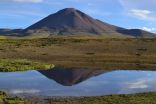Biodiversity belowground is just as important as aboveground
2015-09-02
(Press-News.org) Although most of the world's biodiversity is below ground, surprisingly little is known about how it affects ecosystems or how it will be affected by climate change. A new study demonstrates that soil bacteria and the richness of animal species belowground play a key role in regulating a whole suite of ecosystem functions on Earth. The authors call for far more attention to this overlooked world of worms, bugs and bacteria in the soil.
Ecosystem functions such as carbon storage and the availability of nutrients are linked to the bugs, bacteria and other microscopic organisms that occur in the soil. In fact, as much as 32% of the variation seen in ecosystem functions can be explained by the biodiversity in the soil. In comparison, plant biodiversity accounts for 42%. That is the conclusions of a new study published in Nature Communications led by Peking University and the Center for Macroecology, Evolution and Climate at the University of Copenhagen.
"Biodiversity below ground is neither very visible nor very cute, but pick up a handful of soil and you might find more species there than all of the vertebrates on the planet. We need to turn our attention towards these organisms, if we are to better understand the ecosystems we depend on for a range of functions", says co-author Aimée Classen from the Center for Macroecology, Evolution and Climate.
The study is unique in relating soil biodiversity to a whole suite of ecosystem functions rather than focusing on a few. These were combined in an index called ecosystem multifunctionality (EMF).
"Ecosystems have multiple functions which are all important. They store carbon in soil and biomass which has massive implications for climate change, but they also hold back and release various nutrients which have effects on natural areas as well as agricultural yield. Therefore, we need to be concerned with the multiple functions of ecosystems, what controls them and how this might change with climate change", says Dr. Xin Jing from Peking University.
The study was carried out at 60 different sites of alpine grassland on the Tibetan Plateau in China which was chosen for its extensive variation in climate across sites. Even though rainfall, temperature and pH varied from place to place, the soil biodiversity always influenced ecosystem multifunctionality.
"The results suggest that the same pattern is likely to be found in other ecosystems around the world. However, our study also shows that the effect of soil biodiversity on ecosystem functions may be greater in areas with higher precipitation. That is important because scientific studies often focus on temperature - not precipitation - when predicting how ecosystems will respond to future changes such as climate change", says Associate Professor Aimée Classen.
INFORMATION:
Reference
Jing X, Sanders NJ, Shi Y, Chu H, Classen AT, Zhao K, Chen L, Shi Y, Jiang Y, He J-S. The links between ecosystem multifunctionality and above- and belowground biodiversity are mediated by climate. Nature Communications Doi: 10.1038/NCOMMS9159
[Attachments] See images for this press release:


ELSE PRESS RELEASES FROM THIS DATE:
2015-09-02
CAMBRIDGE, Mass. (September 2, 2015) - Altering the protein recycling complexes in human cells, including cancer cells, allows the cells to resist treatment with a class of drugs known as proteasome inhibitors, according to Whitehead Institute scientists.
"This is why some cancers can be so difficult to treat with chemotherapy, because the cells can be in different states--some sensitive to treatment and some resistant to treatment, all in the same tumor," says Sandro Santagata, a former visiting scientist in the lab of Whitehead Member Susan Lindquist. Santagata is now ...
2015-09-02
Their pregnancies are carried by the males but, when it comes to breeding, seahorses have more in common with humans than previously thought, new research from the University of Sydney reveals.
Seahorses are famed for being part of the only family in the animal kingdom (Syngnathidae) in which the male is responsible for pregnancy. What hasn't been known until now is the degree to which male seahorses nourish and protect their embryos in their brood pouch during the 24-day gestation period.
Findings co-authored by Dr Camilla Whittington from the University's School of ...
2015-09-02
A new study, published today in the British Journal of Pharmacology, by scientists from Royal Holloway, University of London, St George's, University of London and University of Surrey have identified that a drug related to commonly used diabetes treatments provides protection against terminal blood loss.
Massive blood loss often leads to death, and when blood transfusions are unavailable, drugs are currently being tested that can keep people alive until they get to hospital. Understanding how these drugs work, and finding improved drugs, has up to now proved difficult. ...
2015-09-01
MAYWOOD, Ill. - In carefully selected patients, minimally invasive surgery is enabling physicians to stop strokes in their tracks.
And as more stroke patients undergo such procedures, physicians are debating the best way to anesthetize them. Should patients be put under general anesthesia, rendering them unconscious and motionless? Or should they undergo conscious sedation, in which they remain conscious, but are sedated and do not feel pain?
In the September, 2015 issue of the Journal of Stroke and Cerebrovascular Diseases, Loyola University Medical center anesthesiologists ...
2015-09-01
At the International Conference on Intelligent Robots and Systems in September, members of the Singapore-MIT Alliance for Research and Technology (SMART) and their colleagues will describe an experiment conducted over six days at a large public garden in Singapore, in which self-driving golf carts ferried 500 tourists around winding paths trafficked by pedestrians, bicyclists, and the occasional monitor lizard.
The experiments also tested an online booking system that enabled visitors to schedule pickups and drop-offs at any of 10 distinct stations scattered around the ...
2015-09-01
The incidence of bicycle accidents has increased significantly in the U.S. in recent years, with many serious injuries occurring among riders older than 45, according to a new study led by UC San Francisco.
The researchers used a national injury surveillance database to study trends in bicycle injuries from 1998 to 2013. They found that the rate of hospital admissions associated with bicycle injuries more than doubled during that timeframe, especially with head and torso injuries.
Altogether, the proportion of injuries occurring to riders above age 45 rose 81 percent, ...
2015-09-01
KNOXVILLE--The ancestry of man's best friend may be more complicated than its furry coat and soulful eyes betray. Understanding the evolutionary history of the domesticated dog may ultimately help protect endangered wolves, according to a study from the University of Tennessee, Knoxville.
Vladimir Dinets, research assistant professor of psychology, has published an overview examining the confusing and often misunderstood system used to classify dogs and related animals such as wolves and jackals. He has proposed a logical and scientifically sound classification scheme ...
2015-09-01
DURHAM, N.C. -- As governments and industries expand their use of high-decibel seismic surveys to explore the ocean bottom for resources, experts from eight universities and environmental organizations are calling for new global standards and mitigation strategies.
Their goal is to minimize the amount of sound the surveys produce and reduce risks the surveys and other underwater human noise pollution poses to vulnerable marine life.
Firms and agencies conducting the surveys would benefit from these new measures, the experts assert, because instead of having to navigate ...
2015-09-01
BUFFALO, N.Y. - Social interaction could be the mechanism that allows animals living in groups to synchronize their activities, whether it's huddling for warmth or offering protection from predators.
This social presence affects the daily rhythm of activity and rest, and the larger the group, the greater the likelihood of synchronization, according to a study published recently in the journal Biology Letters.
"At least in mice, and perhaps in other animals, this study shows quite dramatic synchrony amongst groups of animals that can only be explained by social interactions," ...
2015-09-01
BUFFALO, N.Y. - Economic well-being for low-income families in the U.S. is often determined by federal measures that establish basic requirements for essentials such as food, shelter and clothing, but a new study by a University at Buffalo research team suggests that such a definition is unrealistically narrow.
To help families move out of poverty, the existing perspective of economic well-being and its short-term focus on basic needs should reflect possibilities for long-term stability, including a savings plan, rather than day-to-day survival, says Yunju Nam, an associate ...
LAST 30 PRESS RELEASES:
[Press-News.org] Biodiversity belowground is just as important as aboveground


